How "Greek fire" saved Constantinople
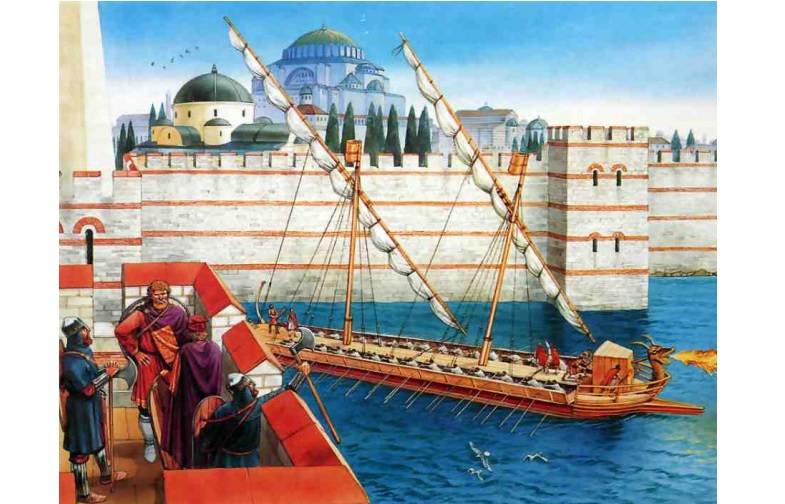
Fire dromon. Hood. Peter Denis. Osprey Publishing.
Mysterious artificial fire
For a number of centuries, as we have already written about, the capital of the Byzantine Empire was saved more than once by the fleet. But these victories would have been completely impossible if there had not been a military-technological miracle of that time - “Greek fire” in service.
It was called Greek by the opponents of Byzantium, while in Byzantium it was called “marine”, “liquid”, “artificial” or “wet”. In this text, I will use all these synonyms.
"Greek fire", along with ancient urban civilization and a number of production technologies, some of which had their origin in Antiquity, and developed agriculture, gave Byzantium the right to be for a long time the center of European civilization, inaccessible to imitate, and the object of envy of neighboring "barbarians" .
The wealth gained from the agrarian economy and handicrafts made it possible for a long time to maintain the army at the proper level, but constant wars for the right to distribute the country's resources, for the title of emperor, significantly undermined the country's strength from within.
But ... "Greek fire" remained an example of unusual medieval technologies that have not come down to us, lost, like many other things. Everything we know comes from written sources that have come down to us, in which there are only descriptions of the use of fire and devices for its use.
It is known that many states and ethnic groups that signed peace treaties with the Romans tried to get this miraculousweapon.
Here is how Constantine VII Porphyrogenitus explained the origin of "liquid fire", who believed that this legend would need to object to embassies wishing to get it:
Thus, in Byzantium, a myth was built around this weapon.
While under the father of Constantine - Leo VI, a law was passed (No. 63), according to which, under pain of the death penalty, it was forbidden to transfer data on "liquid fire" to other states and peoples.
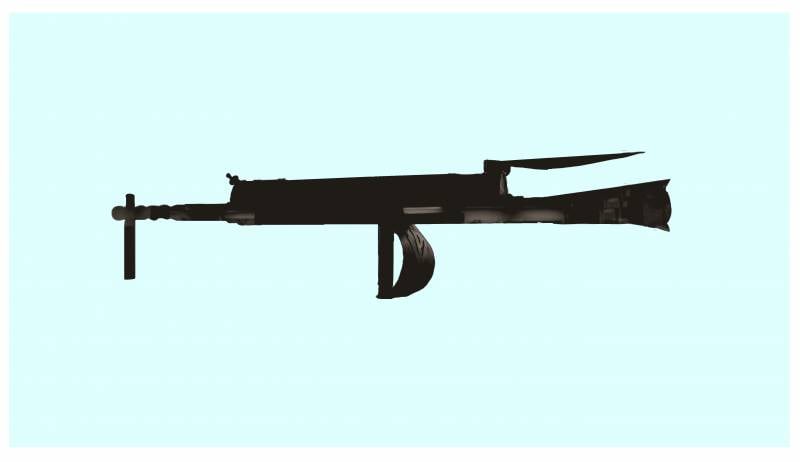
Siphon for "Greek fire". Modern reconstruction. Athens military museum. Greece. The photo was kindly provided by S. Mikhailov.
Before talking about where this invention came from, it should be noted that "Greek fire" is a specific type of weapon.
Sometimes they try to associate with him such weapons as pots of combustible mixture, which were thrown at the enemy, both manually and with the help of mechanical devices. Such weapons were used long before the appearance of "Greek fire" in the zone of the Mediterranean civilization and in other regions: from the Pacific to the Atlantic, throughout the entire medieval stories. Such weapons with "Greek fire" have in common only the result, but technologically these are completely different types of weapons.
When did the "Greek fire" appear or was invented?
This is reported by Theophanes the Byzantine and Constantine VII.
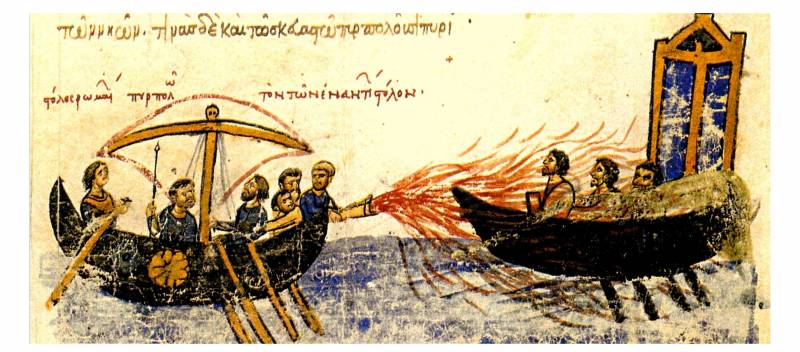
Greek fire. Miniature. John Skilitsa "History of the Byzantine Emperors" Madrid list. XNUMXth century National Library. Madrid.
In 673-677 the Arab fleet besieged Constantinople, while retreating from the city, the Arabs fell into a storm near Cape Silleya in Pamphylia (modern Antalya), and the approaching fleet of the Romans used secret "Greek fire" against the Arabs:
And the honor of inventing such a fire belongs to the Greek Kallinikos. Someone considered him a carpenter, but Feofan called him an architect or architect.
In the medieval period, the profession of an architect was not only a craft of a specialist in the construction of buildings, but often also in the creation of fortresses and fighting machines and tools. An example of this is Aristotle Fioravanti (1415–1485(6)), who built buildings, bridges, poured bells, cannons and conducted siege work.
True, in Byzantium there were also individual specialists in this field: mechanics and geometers. The former were engaged only in the construction of machines, and the latter - in the calculations of buildings and structures.
The inventor Kallinikos was an architect, which means that he was perhaps a generalist in military engineering. He fled from the city of Illiopolis or Helliopolis (the former and present Baalbek, which is 85 km from Damascus). In these territories at that time the majority of the population were Christians, since the Arabs only conquered these places thirty years ago.
Thus, the Greek and architect Kallinikos escaped from the Caliphate and brought an invention that secured the Roman Empire and its capital for a long time.
How did Greek fire work?
In fact, we do not know at all how the "Greek fire" worked. The sources say nothing about this. All hypotheses are speculative. Here are a few of the main ones.
The first option is when the oil was heated in closed boilers, after which air was pumped with bellows, which through the pipe threw this mixture at the enemy.
The second option is a piston flamethrower, which is found among the Chinese in the XNUMXth century.
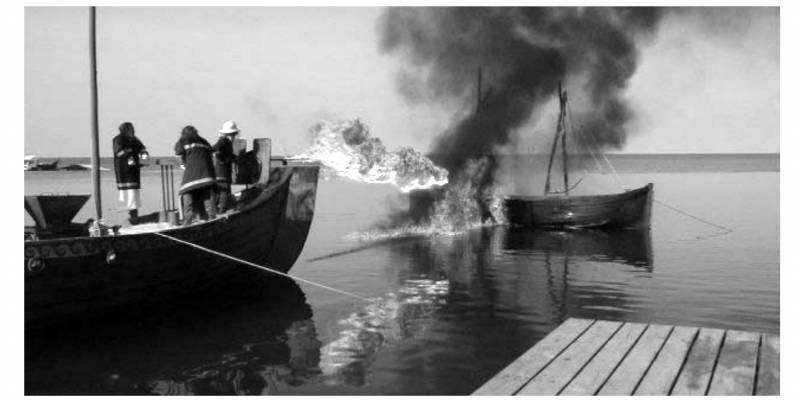
Reconstruction by historians: "Greek fire" ejected from a siphon made and tested by Colin Hughes and Andrew Lacy under the direction of John Haldon. Source: John H. Pryor, E. M. Jeffreys. The age of DROMΩN The Byzantine Navy ca 500–1204. Leiden-Boston. 2006. P. 629.
Another option - a hermetically sealed siphon was heated, after which a valve or tap opened. A lit torch was brought to the outlet, the guide barrel, the escaping mixture ignited, and it could be directed to enemy ships, fortifications, warriors, and the sea burned from it.
But we do not find any of the methods of exploitation in Byzantine sources.
What exactly was used in the form of a liquid in this “sea fire” also remains a mystery. Either oil, or a mixture using oil. Moreover, we know that in Byzantium mixtures were used in fire projectiles, which were thrown by hand or with guns.
In 516, the Athenian philosopher Prok made "magic powder", an explosive mixture that was thrown into the ships of Vitalian, who was besieging Constantinople.
But here Theophanes the Byzantine clearly writes that the sea, erupting fire was a mixture. And it was possible to put it out only with the help of vinegar, as Titmar of Mirzenburgsky and John Keenam wrote about.
But, as a number of modern researchers point out, the mixture was not the key to this technology, it all came down to the training of a specialist who worked at the siphon - siphonator. It was from his experience, the ability to choose the exact warm-up time, the opening of the valve, if any, and similar skills that the successful use of "Greek fire" depended.
With the death of a siphonator in battle, the siphon became a useless weapon. We know that these weapons sometimes fell into the hands of the enemy - Arabs or Bulgarians:
And the Arabs used their "Greek fire" in 835, perhaps after the flight of the strategist Euthymius to them. Further, until the XII century, nothing was heard about the “sea fire” in their hands, when Al-Tarsusi described the Greek fire under the name “naft” to Salah ad-Din, but this was a description of the method of preparing the composition, and not the exact algorithm of application " artificial fire":
Put the resin in a cauldron on fire for a while. At the end, add mineral sulfur ... and remove [from heat], and when the resin boils, add sandarak and beat until a homogeneous mass is obtained.
There is an assumption that the "Greek fire" found itself in Russia in the XII century.
But no one really could use "artificial fire", since most of the medieval technologies were directly related exclusively to specialists who knew how to use them: "from father to son."
So, during the preparation of the expedition to Crete in 949, 30 nomisms (136,5 g, you can recalculate the cost at the current rate) were paid for the purchase of 200 liters of tin for soldering siphons of "artificial fire" by master Michael.
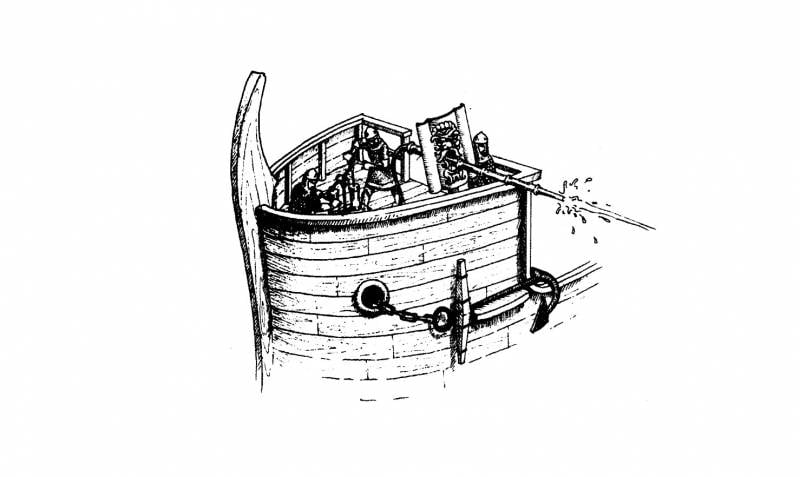
The use of Greek fire. Hood. I. V. Kirsanov. Source: Bannikov A. V., Morozov M. A. History of the military fleet Rome and St. Petersburg: Eurasia, 2014.
Therefore, in the end, such a technology as "sea fire" was lost, however, the disappearance of "fire" occurred on the border of the emergence of a new technology - guns. With their appearance, "Greek fire" became only the property of history. Not surprisingly, quite recently, right before our eyes in modern Russia, the technology of the future, Buran, was lost, so this is found in history.
What did the "Greek fire" look like?
Emperor Leo VI described it in detail:
The siphon is related to the piston pump, described in antiquity by the "father of pneumatics" Ctesibius from Alexandria, Philo of Byzantium, Heron of Alexandria. But these are all hypothetical assumptions, since these inventions are seriously behind in time.
It should be noted that on the pages of two strategies written by the emperors Leo VI and Nicephorus II Phocas, a manual siphon is mentioned, which was used on foot. Leo writes that it was he who invented this weapon. Throwing artificial fire comes from the ranks of warriors covered with shields. Perhaps such an invention could be attributed to the pranks of nobles who could afford some inventions if their budget allowed, but both the warrior and the commander Nikifor Foka describe a manual siphon:
…defeat them with fluid fire.
In other literature of this period, we do not find reports on the use of "artificial fire" from a manual siphon, perhaps after the shameful death of Basileus the warrior Nicephorus at the hands of conspirators, the death of his successor, the warrior and commander John Tzimiskes, their successors were not up to manual siphons.
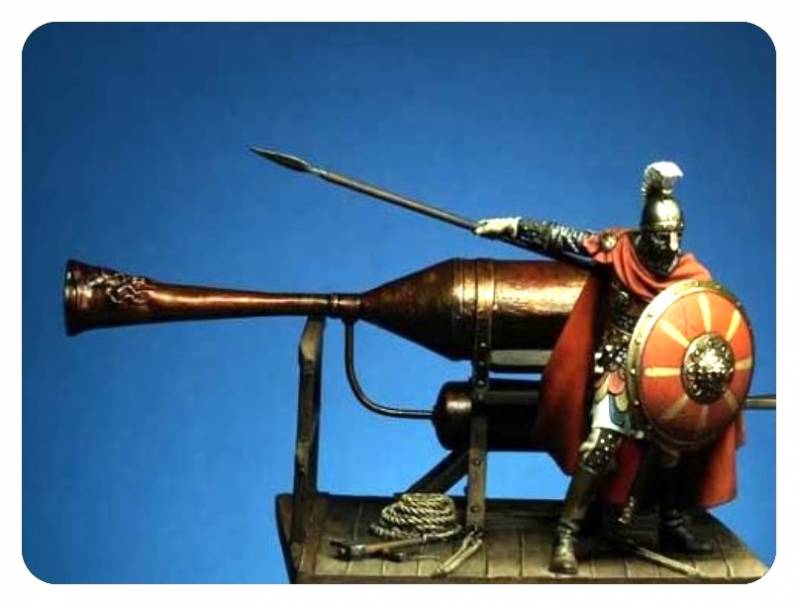
Siphon and warrior. Modern miniature. 54 mm.
On the ship, the siphons were first installed on the bow and stern, from above they were covered with a boardwalk, in addition to the siphons, there were warriors with bows here, who covered the “sea fire” arrow from enemy arrows.
Next to the siphons, the term tetracula is found, perhaps, according to some researchers, this is a stand on four legs, under which a fire was kindled in a brazier.
Liuprandt of Cremona reported that in 941, during the arrival of Russia to Constantinople, the emperor and naval commander Roman Lacapid ordered to equip helandia in a different way than it was before:
Because not all dromons had siphons with "sea fire". As we can see, during the campaign to Crete in 949, 2 ships were fire-bearing, and 000 were not.
The tenth century was the peak of the military and naval victories of the Romans. Leo the Deacon mentions "Greek fire" about fifteen times.
But the huge expenditures spent on the land army led to the fact that the importance of the fleet at the beginning of the 1043th century sharply decreased. When the army of Vladimir Yaroslavovich approached Constantinople in XNUMX,
But, oddly enough, with the fall of the economic, and after it the military power of Byzantium, decorations began to be used in the production of a system that ejected "sea fire". If in the XNUMXth century it was just a siphon, now it is a sculpture with a siphon.
Knowing the experience of the Pisans in naval battles and fearing a battle with them, the emperor placed on the bow of each ship a bronze or iron head of a lion or some other animal - gilded, with gaping mouths, these heads were a terrible sight. The fire, thrown through the pipes at the enemy, passed through their mouths, and it seemed as if it was vomited by lions or other animals.
It was one of the last battles of the Romans, where "Greek fire" was massively used in a naval battle, let's add - and so described in detail:
In the meantime, the wind that suddenly cleared up stirred the sea, began to ruffle the ships and threatened to sink them (the waves raged, the yards creaked and the sails were torn). The barbarians, frightened by the fire (after all, they were not accustomed to projectiles, thanks to which it is possible to direct the flame, which by its nature rises up, anywhere - down and to the sides) and frightened by the storm, decided to take flight.
One important point should be noted here, given the possibility of causing a fire on your own ship, “Greek fire” was used exclusively in calm seas, as Liuprandt of Cremona wrote about back in the 941th century. In the battle with the flotilla of Prince Igor in XNUMX, the Romans were able to use “sea fire”, since the sea calmed down on the eve of the battle, otherwise it would have been difficult to do so.
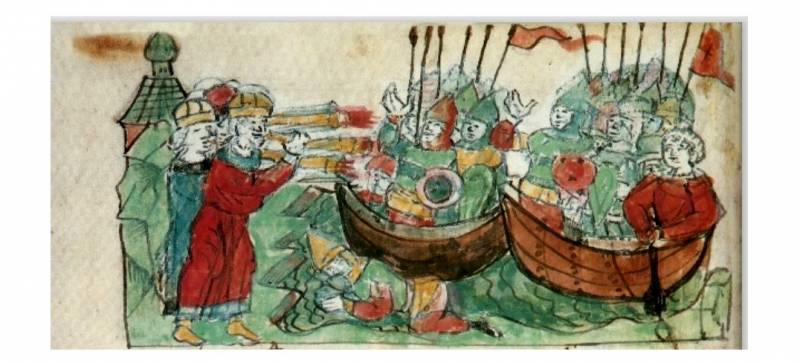
Battle of Prince Igor with the Byzantines. Radzivilov Chronicle. XNUMXth century Miniature.
As early as the 1151th century, "Greek fire" was used sporadically. John Kynam reports its single use against the Hungarian fleet on the Danube, during the war of 1171. In XNUMX, the Venetians arrested in Constantinople fled on a large three-masted ship, followed by a fire-bearing dromon. The Romans threw fire at the high-speed ship, according to Nikita Choniates, they could not get in because of the sea and the speed of the fugitives' ship, and according to John Kinama, the Venetians knew about the Byzantines' capabilities and doused their ship with bite in advance, which saved them from " sea fire.
Where did the "Greek fire" go?
Where did the "Greek fire" go by the time the crusader fleet arrived at Constantinople in 1204, is it unclear?
If we do not take into account the version that
Therefore, even during the siege of Constantinople by the crusaders, "Greek fire" was no longer used, and an attempt to use fire-ships against the crusader fleet was unsuccessful.
Here it will be appropriate to recall what happened in this very place where the crusaders stood, when the warrior-emperor John Tzimisces looked at the dromons with "Greek fire" in 970:
To be continued ...
Information